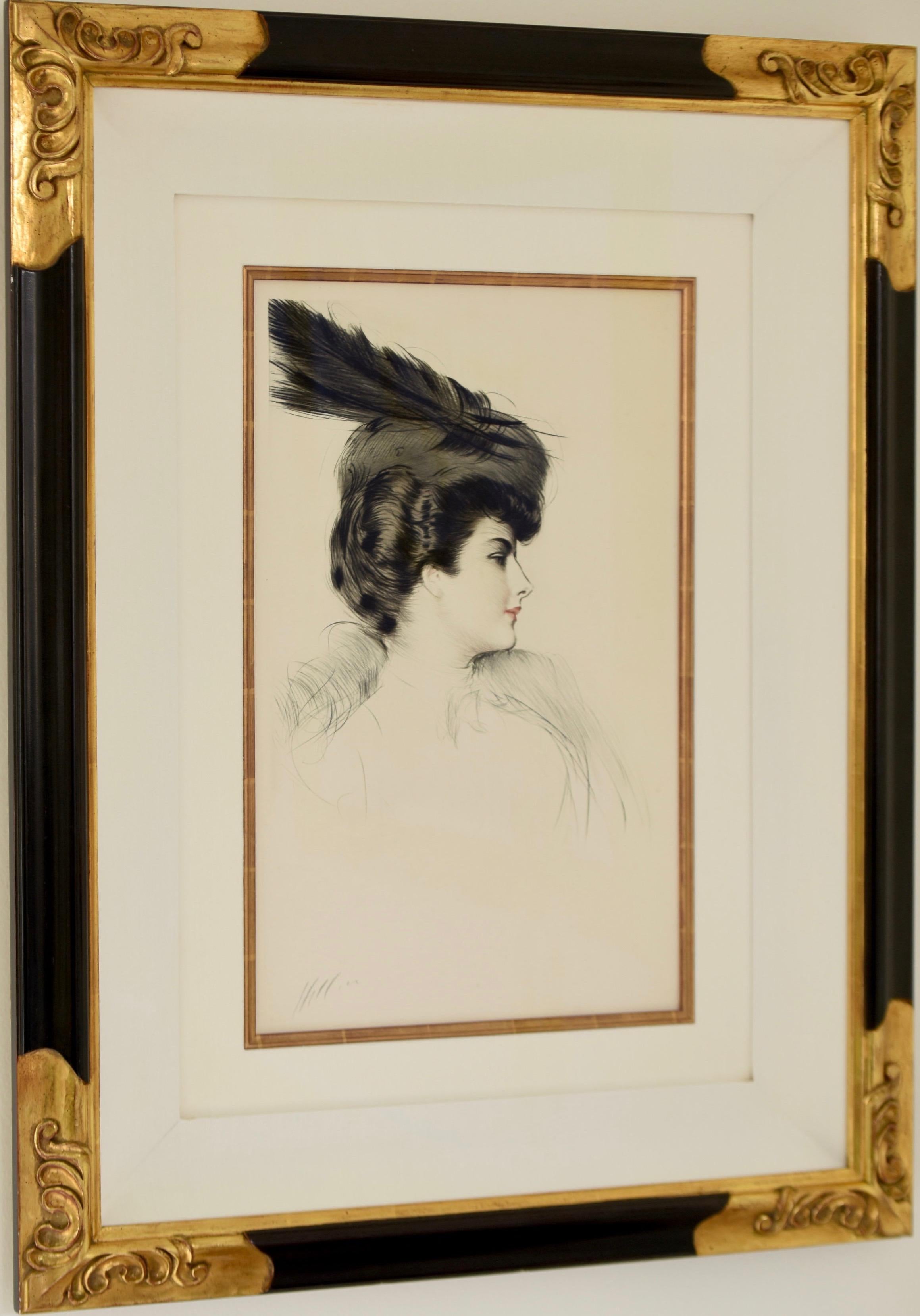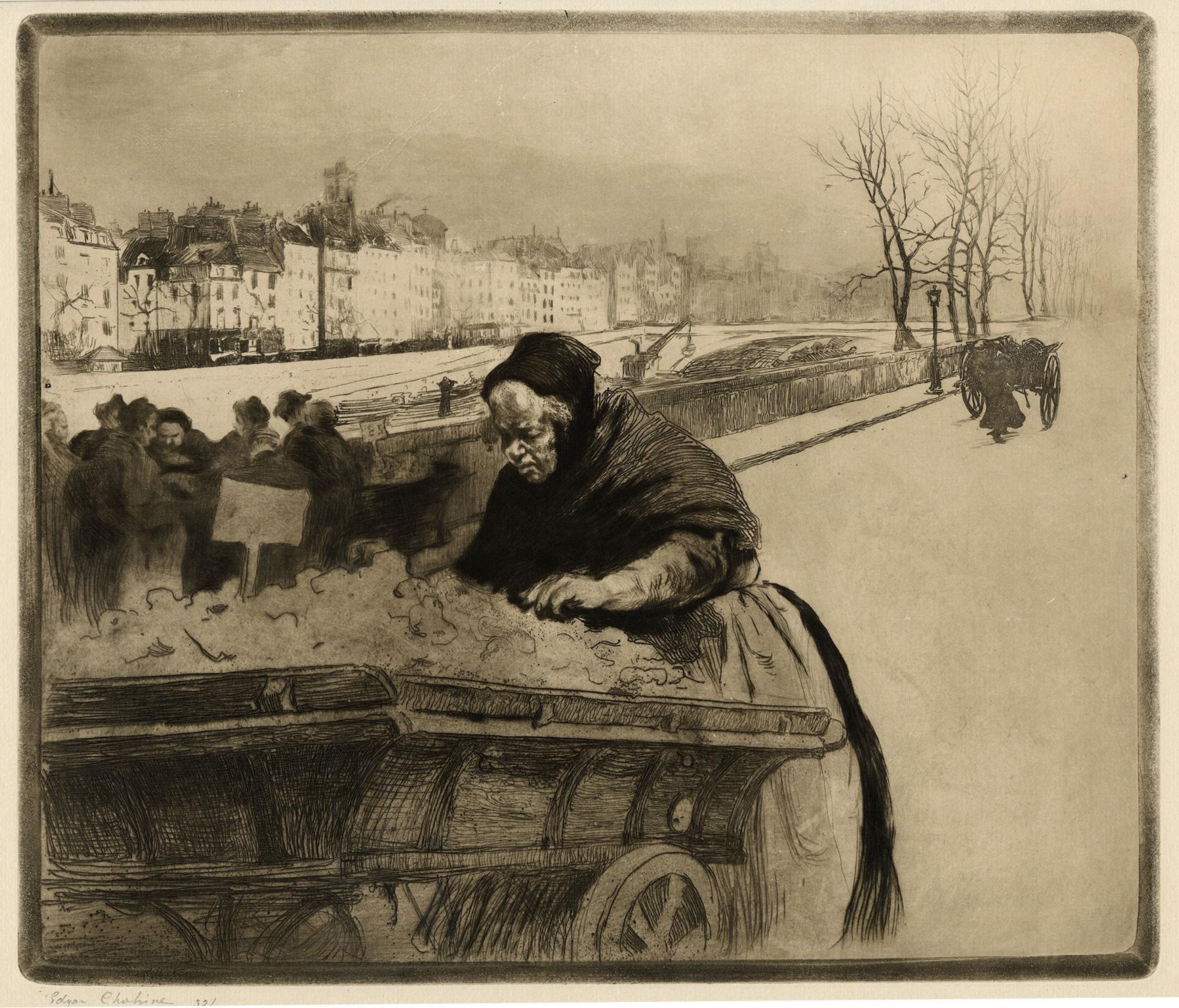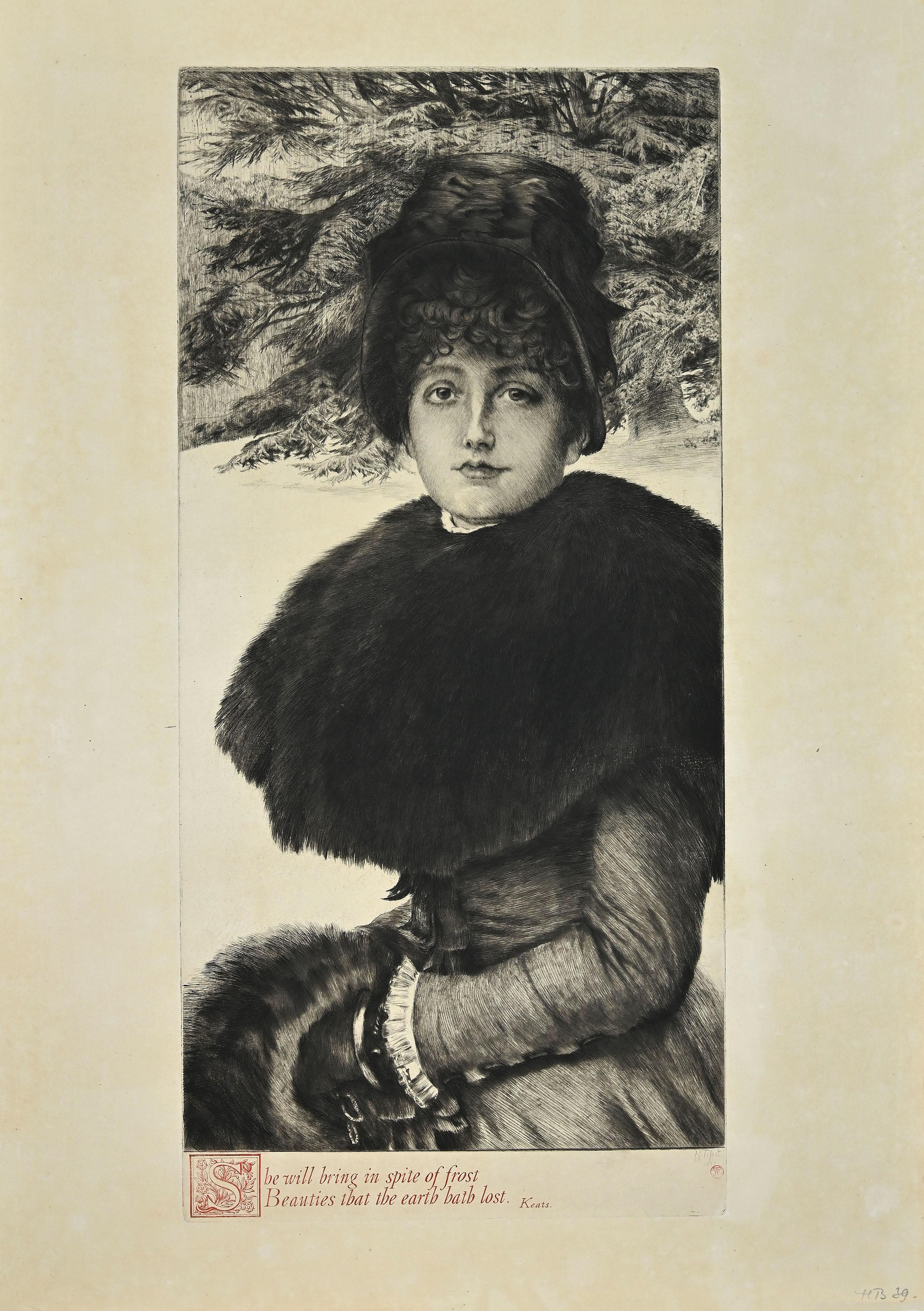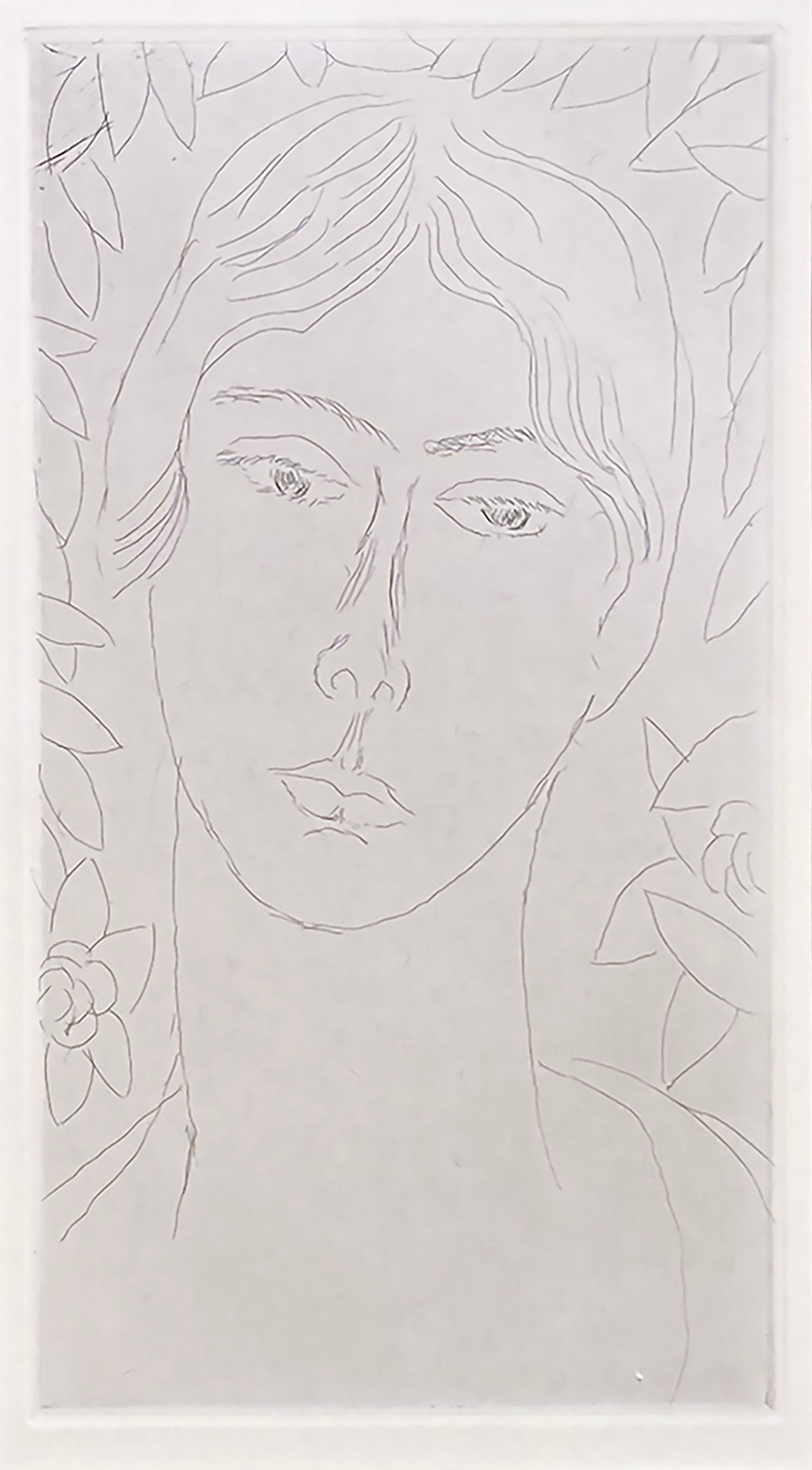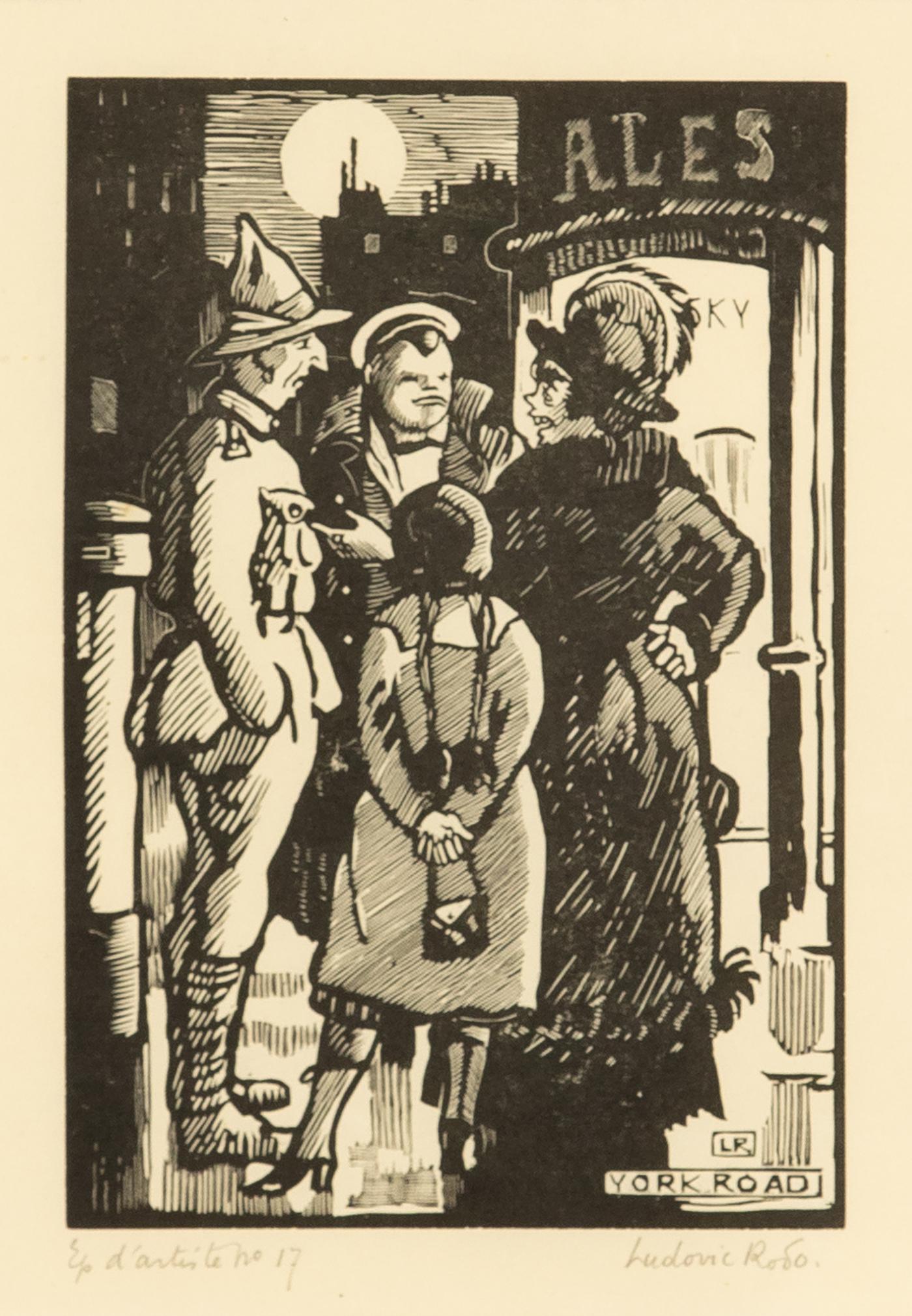Items Similar to La Couseuse (The Seamstress)
Want more images or videos?
Request additional images or videos from the seller
1 of 2
Jacques VillonLa Couseuse (The Seamstress)1905
1905
About the Item
Jacques Villon (1875-1963), La Couseuse (The Seamstress), drypoint, 1905, signed in pencil lower right margin. Reference: Ginestet and Pouillon 147, Auberty and Perussaux 96. On a heavy cream laid paper with a partial initials watermark. In good condition apart from slight time stain; soft fold along a laid paper line, a few marks in margins. Archival mounting. With margins, 6 3/8 x 6 3/8, the sheet 8 1/2 x 11 1/4 inches.
A fine, black atmospheric impression, with the drypoint burr fresh and satiny.
This is an exceedingly rare impression. When Ginestet and Poullon did their recent catalogue raisonne of Villon’s prints they were unable to locate an impression, and so made a photo of the impression shown in the very early Auberty and Perussaux catalogue. This impression is before any burnishing of the plate (if indeed it was burnished), so the platemarks are quite prominent. It was never editioned and exists in at most a few impressions.
In this relatively early period in Villon’s career as a printmaker, he made a number of color aquatints, and also began a series of very personal drypoints of his (and his sister Suzanne and his brother Marcel Duchamp’s) family as well as those of children (including the famed Minne series). This extraordinarily successful portrait appears to be within the latter tradition.
- Creator:Jacques Villon (1875-1963, French)
- Creation Year:1905
- Medium:
- Movement & Style:
- Period:
- Condition:
- Gallery Location:New York, NY
- Reference Number:1stDibs: LU51531465283
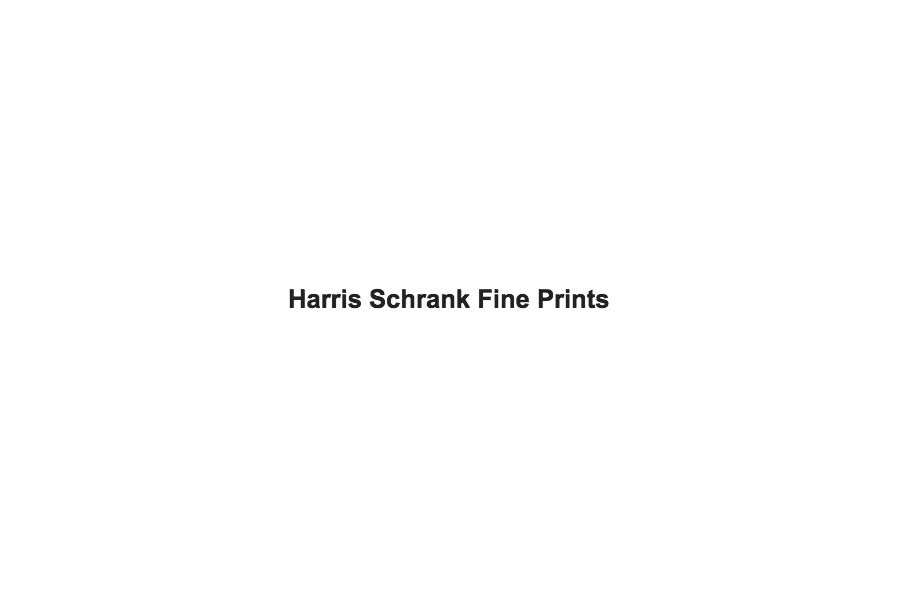
About the Seller
4.9
Recognized Seller
These prestigious sellers are industry leaders and represent the highest echelon for item quality and design.
Established in 2000
1stDibs seller since 2016
99 sales on 1stDibs
Typical response time: 3 hours
Associations
International Fine Print Dealers Association
- ShippingRetrieving quote...Ships From: New York, NY
- Return PolicyA return for this item may be initiated within 7 days of delivery.
More From This SellerView All
- Whistler Portrait No. 7 (Six Faces of Whistler)By Mortimer MenpesLocated in New York, NYMortimer Menpes (1855-1938), Whistler Portrait No. 7 (Six Faces of Whistler), drypoint, 1902-3, signed in pencil and inscribed “imp” bottom right margin. Reference: Morgan 237. Water...Category
Early 1900s Realist Portrait Prints
MaterialsDrypoint
- SimilitudesBy Jean-Louis ForainLocated in New York, NYJean- Louis Forain (1852-1931), Similitudes, etching and drypoint, not signed [signed in the plate upper right], 1880, from the total edition of 545, on wove paper, in generally good...Category
1880s Realist Portrait Prints
MaterialsDrypoint
- The Barker (Self Portrait)By Max BeckmannLocated in New York, NYMax Beckmann (1884-1950), The Barker (Self Portrait), drypoint, 1921, from Der Jahrmarkt. Reference: Hofmaier 191 IIB.b. From the edition of 125 on wove paper (there was also an edition of 75 on Japan). With the blindstamp of Mariees Gesellschaft, Munich. In very good condition, the full sheet, with deckle edges, 13 1/8 x 10 1/2, the sheet 20 3/4 x 15 inches, archival mounting. A fine impression. Only a few proofs were made of the first state; in the second state Beckmann strengthened some of the letters in the sign at the left but made no changes to the composition. Four proofs were made (this is Hofmaier’s IIA; then came the edition, IIB, in two sections, the 75 proofs on Japan, and the 125 on wove. In this introductory plate to the 10 drypoint set Der Jahrmarkt (The Fair) Beckmann is shown next to the small advertising card...Category
1920s Expressionist Portrait Prints
MaterialsDrypoint
- Adresse Sagot - Two States, Before and After LetteringBy Jacques VillonLocated in New York, NYJacques Villon (1875-1963), two drypoints, 1905, (Ginestet and Pouillion E156) each signed in pencil: an impression of the final state (third state of three) printed in bistre, with ...Category
Early 1900s Impressionist Portrait Prints
MaterialsDrypoint
- Saints Simon and MatthewLocated in New York, NYISRAHEL VAN MECKENEM ca. 144045 Bocholt 1503 Saints Simon and Matthew engraving; 212 x 142 mm Geisberg 249; Lehrs and Hollstein 298 first state (of two) WATERMARK quartered coat ...Category
15th Century and Earlier Old Masters Portrait Prints
MaterialsEngraving
- Panel with a MascaronBy Hans Sebald BehamLocated in New York, NYHans Sebald Beham (1500-1550), Panel with a Mascaron, engraving, 1543 [with the initials monogram and date in the plate]. Reference: Bartsch 231, Hollstein 235. Second state (of 2). ...Category
16th Century Old Masters Portrait Prints
MaterialsEngraving
You May Also Like
- "Dame a la Toque", fabulous drypoint etching by Paul Cesar HelleuBy Paul César HelleuLocated in Hinsdale, ILHELLEU, PAUL CÉSAR (1859 - 1927) "La Dame a la Toque" (Lady in Fur Hat) Drypoint printed in colors on pale cream wove paper, c. 1906 Signed in black crayo...Category
Early 20th Century Post-Impressionist Portrait Prints
MaterialsDrypoint
- La Marchande des Quatres-SaisonsBy Edgar ChahineLocated in Middletown, NYEtching with drypoint on cream wove paper, 11 3/4 x 13 3/4 inches (297 x 347 mm), full margins. Signed in pencil and numbered 32/40, lower margin. Minor mat tone and several small lo...Category
Early 20th Century Post-Impressionist Portrait Prints
MaterialsHandmade Paper, Rag Paper, Drypoint, Etching
- Promenade dans la Neige - Etching by J. Tissot - 1880By James TissotLocated in Roma, ITBeautiful print on verge crème, 2° state on 3, with letters printed in red. Stamp “Lugt 1545”. Little crack and fold on lower left margin of the sheet. Some small traces of oxidati...Category
1880s Post-Impressionist Portrait Prints
MaterialsDrypoint, Etching
- "Dame a la Toque", fabulous drypoint etching by Paul Cesar HelleuBy Paul César HelleuLocated in Hinsdale, ILHELLEU, PAUL CÉSAR (1859 - 1927) "La Dame a la Toque" (Lady in Fur Hat) Montesquiou XXXVI, c. 1906 Drypoint printed in colors on pale cream wove paper Signed in black crayon lower ...Category
Early 20th Century Post-Impressionist Portrait Prints
MaterialsDrypoint
- "Mlle Landsberg" (grade planche, pl. 16)By Henri MatisseLocated in Missouri, MO"Mlle Landsberg" (grade planche, pl. 16), 1914 Henri Matisse (French, 1869-1954) Signed and Numbered Lower Right Edition 12/15 Image size: 7 7/8 x 4 5/16 inches Sheet size: 17 11/16 x 12 1/2 inches With frame: 19 1/2 x 14 1/2 inches Henri Matisse came from a family who were of Flemish origin and lived near the Belgian border. At eight o'clock on the evening of December 31, 1869, he was born in his grandparents' home in the town of Le Cateau in the cheerless far north of France. His father was a self-made seed merchant who was a mixture of determination and tightly coiled tension. Henri had no clear idea of what he wanted to do with his life. He was a twenty-year-old law clerk convalescing from appendicitis when he first began to paint, using a box of colors given to him by his mother. Little more than a year later, in 1890, he had abandoned law and was studying art in Paris. The classes consisted of drawing from plaster casts and nude models and of copying paintings in the Louvre. He soon rebelled against the school's conservative atmosphere; he replaced the dark tones of his earliest works with brighter colors that reflected his awareness of Impressionism. Matisse was also a violinist; he took an odd pride in the notion that if his painting eye failed, he could support his family by fiddling on the streets of Paris. Henri found a girlfriend while studying art, and he fathered a daughter, Marguerite, by her in 1894. In 1898 he married another woman, Amelie Parayre. She adopted the beloved Marguerite; they eventually had two sons, Jean, a sculptor and Pierre who became an eminent art dealer. Relations between Matisse and his wife were often strained. He often dallied with other women, and they finally separated in 1939 over a model who had been hired as a companion for Mme. Matisse. She was Madame Lydia, and after Mme. Matisse left, she remained with Matisse until he died. Matisse spent the summer of 1905 working with Andre Derain in the small Mediterranean seaport of Collioure. They began using bright and dissonant colors. When they and their colleagues exhibited together, they caused a sensation. The critics and the public considered their paintings to be so crude and so roughly crafted that the group became known as Les Fauves (the wild beasts). By 1907, Matisse moved on from the concerns of Fauvism and turned his attention to studies of the human figure. He had begun to sculpt a few years earlier. In 1910, when he saw an exhibition of Islamic art, he was fascinated with the multiple patterned areas and adapted the decorative universe of the miniatures to his interiors. As a continuation of his interest in the "exotic", Matisse made extended trips to Morocco in 1912 and 1913. At the end of 1917, Matisse moved to Nice; he would spend part of each year there for the remainder of his life. A meticulous dandy, he wore a light tweed jacket amd a tie when he painted. He never used a palette, but instead squeezed his colors on to plain white kitchen dishes...Category
1910s Fauvist Figurative Prints
MaterialsEtching, Drypoint
- York Road by Ludovic-Rodo Pissarro - Wood engravingBy Ludovic-Rodo PissarroLocated in London, GBYork Road by Ludovic-Rodo Pissarro (1878-1952) Wood engraving 13.2 x 9 cm (5 ¹/₄ x 3 ¹/₂ inches) Initialed and titled in the plate, signed lower right, Ludovic Rodo and numbered lowe...Category
1910s Post-Impressionist Portrait Prints
MaterialsEngraving
Recently Viewed
View AllMore Ways To Browse
The Seamstress
Art The Seamstress
Suzanne Duchamp
American Sporting Art Etchings
Marilyn Rosenthal
Three Stooges
Picasso Imaginary Portraits
Picasso Le Gout
Vanity Fair Spy Prints
Warhol Reigning Queens
Brock And Co
Robin Morris On Sale
Andy Warhol Joseph Beuys
Chapeau Vintage Femme
Le Gout Du Bonheur
Warhol Superman
Stone Marten
Andy Warhol Reigning Queens
